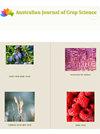Cover crops biomass yield grown as a 2nd summer crop in relation to sowing periods
Q3 Agricultural and Biological Sciences
引用次数: 1
Abstract
The aim of this study was to evaluate cover crop precocity and biomass yield growth as a 2nd summer crop after soybean at different sowing periods (January 2nd; February 2nd and March 2nd at 2019 and January 27th and March 3rd at 2020). Experiment was laid out as a randomized block design in a 3x3 factorial for each sowing period, in the 2019 and 2020 off-seasons, being factor A represented by the cover crops (Urochloa brizantha cultivar Xaraés, Crotalaria juncea cultivar IAC-KR-1 and Pennisetum glaucum cultivar ANm 38,) and factor B by the evaluation periods along cover crops development cycle. There was an interaction between cover crops and evaluation period for plant height and dry matter yield for both years. C. juncea and P. glaucum showed faster growth, regardless of the evaluation period and sowing periods, compared to U. brizantha in both years. Cover crop biomass yield reduced as sowing period is delayed from January to March to an extend that P. glaucum yield dropped from 14.6 to 4.2 t DM ha-1 at 2019 and from 14.4 to 6.9 t DM ha-1 at 2020 as a result shorter photoperiod and lower temperature. The same was noticed to U. brizantha and C. juncea which showed yields of 11.676 and 8.800 and 2.220 and 2.555 kg ha-1 at April 29th of 2019 and 12.507 and 7.812 and 3.041 and 2.346 kg DM ha-1 at June 18th 2020 respectively for January and March sowing periods. U. brizantha and C. juncea are more viable 90 days, while P. glaucum showed the fastest dry matter accumulation rate. All species are viable due to the benefits they provide to the productive system, which becomes more diversified and therefore more sustainable覆盖作物作为第二夏季作物的生物量产量与播期的关系
本研究的目的是评价不同播期(1月2日;2019年2月2日和3月2日,2020年1月27日和3月3日)。试验采用3 × 3因子随机区组设计,在2019年和2020年的淡季,每个播期采用3 × 3因子设计,因子a以覆盖作物为代表(黑斑草品种xaramacos、黄爪草品种IAC-KR-1和白盆草品种ANm 38),因子B以覆盖作物发育周期为评价期。覆盖作物与评价期在株高和干物质产量上均存在交互作用。不论评价期和播期,两年内芥菜和青花的生长速度都快于棘豆。由于播期从1月推迟到3月,覆盖作物生物量产量下降,且由于光期较短、温度较低,覆盖作物产量从2019年的14.6下降到4.2 t DM ha-1,到2020年从14.4下降到6.9 t DM ha-1。2019年4月29日和2020年6月18日,brizantha和juncea的产量分别为11.676、8.800、2.220和2.555 kg hm -1和12.507、7.812、3.041和2.346 kg DM hm -1。在90 d内活菌量最大的是棘花和芥菜,而青花的干物质积累速率最快。所有物种都是可行的,因为它们为生产系统提供了好处,使生产系统变得更加多样化,因此更具可持续性
本文章由计算机程序翻译,如有差异,请以英文原文为准。
求助全文
约1分钟内获得全文
求助全文
来源期刊

Australian Journal of Crop Science
农林科学-农艺学
CiteScore
1.20
自引率
0.00%
发文量
75
审稿时长
3.5 months
期刊介绍:
Information not localized
 求助内容:
求助内容: 应助结果提醒方式:
应助结果提醒方式:


